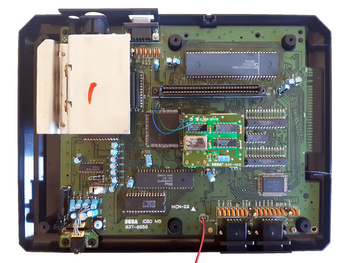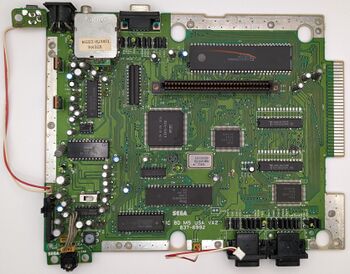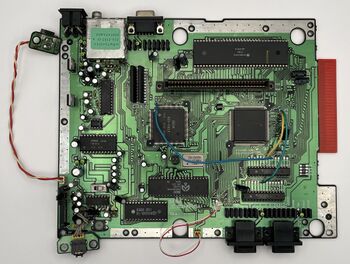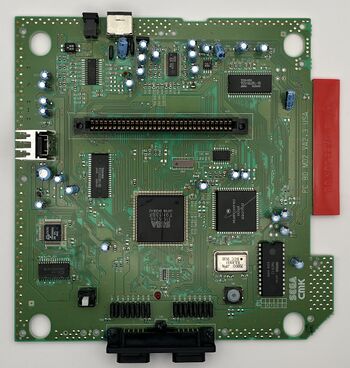Genesis:Motherboard Differences
Some page content & researching taken from io55.net's Sega Genesis page with permission, in collaboration.
There were numerous motherboard revisions of the standalone Genesis and Mega Drive consoles. This page serves to document these board revisions and the technical information for each.
Model 1
837-6656 - "VA0" (1988, Japan)
This is the earliest revision of the model 1 and is only found in Japanese Mega Drive consoles. These are distinguished internally by a small daughterboard (part number 839-0231) which contains the master oscillator crystal and a few logic chips. During manufacturing, Sega discovered that the EDCLK (external dot clock) signal did not work properly in the H40 video mode, and this daughterboard generates a fixed EDCLK signal which is fed back into the VDP. Sega also included a discrete 74LS00 logic gate on the motherboard to fix RAM compatibility issues with Master System games.[1]
Although the board is not designated as such, it is commonly referred to as the "VA0" in keeping with Sega's revision naming practices and the fact that it was the first board revision produced.
The VA0 revision also has a significant flaw with its stereo audio output. While the balance between frequencies is excellent, the preamp is far too high, resulting in horrible distortion in games that are too loud. However, this can be fixed by substituting several capacitor and resistor values on the underside of the motherboard. Composite video is also rather subpar as it is blurred and is afflicted with "rainbow banding" which covers the entire screen.
VA1 (1989, Japan)
Introduced very early in 1989, the VA1 incorporates the EDCLK daughterboard and discrete 74LS00 chip into the motherboard by adding an additional chip, the 315-5339. Like the "VA0" before it, this board is only found in Japanese Mega Drives and also has the same issue with the overdriven preamp.
VA2 (1989, Japan and North America)
This is the first board revision for the Genesis and is also found in Japanese Mega Drive consoles. On this revision, the 315-5339 EDCLK generator chip was replaced with the 315-5345, which added an additional bus acknowledgment signal (/BGACK) going to the VDP. It uses this signal to prevent potential glitches related to the VDP's DMA (direct memory access) refresh timing.[2] No other changes were made and the overdriven preamp issue was also carried over.
Sega made some changes to the board layout for North American models in order to accommodate an internal RF modulator and RF shielding, neither of which the Japanese Mega Drive ever had. These changes plus the retention of the EXT port meant that the power input jack had to be moved onto a separate PCB, connected to the motherboard by two wires.
These layout differences between regions would be carried on into all later model 1 revisions until the VA7.
VA3 (1989-1991, Brazil and North America
Introduced in late 1989, the VA3 revision was only used in North American and Brazilian consoles (being the first revision for the latter). The 315-5308 bus arbiter and 315-5345 EDCLK generator were consolidated into a single IC, the 315-5364, likely to reduce production cost. In addition, the audio circuitry was changed as the overdriven preamp issue from previous revisions was fixed and some low pass filtering was added to the output stage, which slightly muffled the audio.
VA4 (1989-1992, Japan, Korea and PAL)
The VA4 is largely identical to the VA3, and was first introduced in late 1989 in Japanese Mega Drive consoles. It was also the first board revision for PAL and Korean consoles.
VA5 (1990-1991, Asia and Japan)
Introduced in late 1990, this board design saw further consolidation by combining the 315-5309 I/O chip and 315-5364 bus arbiter into a single ASIC, the 315-5402. Composite video output was moderately improved with the reduction of the "rainbow banding" common on earlier revisions, and the excellent audio quality of the VA3 and VA4 boards was carried over. This particular board revision was only used in Asian and Japanese Mega Drives. Asian boards used the board layout from the export models as they had an internal RF modulator and shielding.
VA6 (1991-1992, Asia, Brazil, Japan and North America)
Identical to the VA5 but substitutes the I/O chip with the 315-5433, which adds the TradeMark Security System (TMSS) lockout screen ("Produced by or Under License by Sega Enterprises, Ltd") that appears for several seconds before playing any game. This was added in order to deter unlicensed games and first appeared in US Genesis consoles, with other regions following later in 1991.
VA6.5 (1992-1993, North America and PAL)
The VA6.5 is simply a VA6 with the EXT port and its line filters removed, since the EXT port was unused in Western markets. No other changes were made. The "VA6.5" name originates from Sega service documentation and is not denoted on the board itself.
VA6.8 (1992, PAL)
Only found in European Mega Drives, the VA6.8 revision is largely identical to the VA6 but has a surface-mount Fujitsu MB3514 video encoder in place of the DIP Sony CXA1145P found in all other models. No other changes were made.
VA7 (1992-1993, Brazil, Japan and North America)
Introduced in late 1992, the VA7 was the final and most drastic revision of the model 1 released. It is the first standalone Genesis/Mega Drive to use the FC1004 ASIC found in most model 2 consoles, which combines the 315-5313 VDP, 315-5433 I/O controller, and a modified Yamaha YM3438 audio chip into a single chip. All VA7s use a surface-mount version of the Sony CXA1145 encoder, a PLCC version of the Motorola 68000 CPU, and only a single 7805 voltage regulator as opposed to two like on previous board revisions. Both the main RAM and Z80 RAM were also changed to SOP type surface mount chips.
On non-Japanese consoles, the ports on the back have been shifted significantly to the left-hand side, having the AV out occupy where the EXT port used to be (except on Japanese VA7s which still have the EXT port present), which leaves a large gap to the right. This was also the first Western revision to have the power jack on the motherboard itself, as the revamped board layout allowed for having both the RF modulator and power jack on the same PCB.
The sound output is notoriously bad when compared to other revisions; it is muffled, filled with hiss, and possesses a flat frequency range with excessive distortion. This is due to Sega using an inadequate amplifier circuit and can be corrected using a modification board such as the Triple Bypass or Mega Amp. Some of the components in the audio circuitry can also be swapped with different ones to improve the audio quality without these boards. Despite this, composite video quality is slightly better than on previous revisions.
Model 2
VA0, VA1 and VA1.8 (1993-1996, All Regions)
These are for the most part, very similar to the VA7 model 1 with many of the same components. The Z80 CPU was changed to a much smaller QFP (quad flat pack) type in order to save space.
The sound quality still suffers though is not as bad as the VA7, leaving only the incessant hissing. At times, the video output may also be very poor if the console uses the Samsung KA2195D video encoder; this is something that can only be determined by opening the console. Some VA0 and VA1 consoles may have the Sony CXA1145M as used in the VA7 model 1, while most PAL consoles have the Fujitsu MB3514.
The VA1 differs from the VA0 mainly in that it consolidates the two VRAM chips and two 68K RAM chips with one chip each - and there are major trace routing changes to accommodate this. However, there are also some resistor values changed in the audio circuit that likely reduce distortion in these later revisions: R42 through R45 are increased from 4.7 kohm to 7.5 kohm, while R81 is decreased from 7.5k to 6.8k.
It is unclear what exactly is different between the VA1 and VA1.8, as the boards appear mostly identical with the exact same components and no documentation of this difference has been found. Some VA1.8 boards have two wires between the positive and negative pins of the power jack and two solder pads on the underside which are not present on earlier boards.
All of these board revisions come with or without HAL (Hot-Air Solder Leveling), although the "HAL" text is not always present on the boards which have it. In addition, all three of these board revisions also come with or without plated through-holes, and the layout is slightly different between these variations. The non-plated variations have extra vias. The non-plated variations also have jumper links in place of some power traces.
In Japan, the Mega Drive 2 only features either the VA0 or VA1 revision; later board revisions did not appear in Japan due to the Mega Drive's unpopularity there. For some unknown reason, Japanese and Asian Mega Drive 2 consoles use a slide switch for power like the model 1 instead of a push button switch, and lack a power LED.
Early Brazilian Mega Drive III consoles have a VA0 board but with a small RF modulator board crudely soldered onto the side of the board, with the RF output jack sticking out of the side of the console. In later versions, TecToy used a board revision of their own design, which was heavily based on the VA1/VA1.8. This revision integrated the RF out on the motherboard (with the output jack now at the rear) and featured an internal power supply with switchable input voltage.
VA2/2.3 (1994-1996, North America)
Sound-wise, these are noticeably better than the 7/0/1/1.8 revisions, but it is still not perfect. Hissing is removed, but volume balance in regards to PSG sound and external audio from both the cartridge and expansion ports are all faulty in some way. These are also the only revisions of the model 2 which have a discrete YM2612 like most model 1s, as the ASIC used in these revisions does not have a YM3438 core. Sega used the 315-5684 audio amplifier chip as opposed to the dual LM324-based setup used in previous model 2 revisions. All VA2 consoles make use of the Samsung KA2195D video encoder while some VA2.3s have the Sony CXA1645 instead, an improved version of the CXA1145 used in previous consoles.
Internally, the VA2 can be identified by the presence of a small "bodge" PCB with several wires connected to it while the VA2.3 lacks this board.
Sega used two different ASICs in the VA2.3, the 315-5685 and 315-5786, both manufactured by Toshiba. The 5685 has a flawed VDP core, which causes odd graphical errors and ghosting as seen in this screenshot. This issue was fixed in the 5786. Aside from a visual inspection of the ASIC itself, running the color bar test in the 240p Test Suite utility can quickly reveal what ASIC the console uses. All VA2s used the 5786.
Both board revisions are only found in North American Genesis consoles.
For the following model 2 revisions, the motherboard’s size has been reduced by a quarter lengthwise. To determine the difference, look at the bottom of a model 2. If the metal shielding visible through the exhaust vents end a significant distance from the edge of the console, it is a ¾ motherboard. If the metal plates practically touch the edge of the console, it is a full size board.
VA3 (1994-1996, North America)
The first of the short board revisions. It uses a variant of the FC1004 ASIC as used in the VA0 through 1.8, but has a simplified audio section based on the 315-5684 amplifier chip instead of two separate LM324 op-amp chips. This in addition to some layout changes allowed Sega to reduce the size of the motherboard, cutting down production costs in the process.
Identifying these can be done by looking for square cutouts on the RF shielding visible through the bottom vents. If the shielding has no square cutouts, it is of this revision; if there are cutouts, it will be the VA4 revision. Sega used three different video encoders on the VA3, the CXA1145M, CXA1645 and the KA2195D. The encoder used can be roughly determined by the serial number; if it starts with "163" or "253", it is almost guaranteed to have a Samsung encoder. Serials starting with "743", "753" or "R43" are extremely likely to have a Sony encoder.
Sound is universally improved on the VA3, resulting in audio quality close to the first model 1s (although with a minor difference in the PSG volume).
Like the VA2 and VA2.3 consoles, this board revision is only found in US Genesis consoles.
VA4 (1996-1998, Asia, North America and PAL)
This was the final board revision for the model 2 and appears to be the best for both audio and video quality. All video issues have been eliminated, as the Sony CXA1645 video encoder chip in these is back to being crisp, colorful, and vivid. Furthermore, the sound has been improved a little more, with less DAC noise than on the VA3. To identify one of these, look for two square cutouts on the shielding visible through the bottom vents. These will also have compatibility issues with the MK-84000 model of the 32X.
The VA4 is especially notable in that it is the first Genesis console to use a GOAC (Genesis On A Chip) ASIC, specficially the Sega 315-5960 (Yamaha FJ3002). This incorporates all of the major components of the console into a single chip, save for the main RAM, video RAM, video encoder and audio amplifier. Due to this change, the VA4 also consumes far less power than any other model 2.
Later VA4s in North America were sold under license by Majesco in 1998, who marketed the Genesis as a budget console. The build quality is largely identical to the earlier Sega-built examples. This was also the final board revision for the PAL Mega Drive II. PAL VA4 boards also feature a ROHM BH7236AF encoder, which is pin-compatible with the CXA1645.
Genesis 3
VA1 (1998)
Essentially a highly condensed VA4 model 2 without an expansion port. Although it is not compatible with the 32X or Master System games, it can be modified for these due to it using the same 315-5960 GOAC as the VA4 model 2. One other major change is that stereo sound was omitted, and all audio goes through a single LM324 op-amp. The Sony CXA1645 video encoder was also carried over, providing decent quality composite video output and RGB.
VA2 (1998-1999)
The VA2 uses a different GOAC, the 315-6123 (Yamaha FQ8002). This differs from the 315-5960 in that the main RAM is integrated, leaving only the video RAM, video encoder and audio amplifier as the only remaining discrete ICs. 32X and Master System compatibility cannot be restored on this revision; only Game Genie and Virtua Racing compatibility issues are fixable on the VA2. The TAS instruction in the 68000 CPU was also fixed, which breaks compatibility with the game Gargoyles. Video output quality was not changed, but the audio is a little better in low frequencies, and does not hiss.






